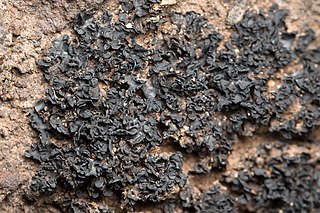
Lichinales is the sole order of ascomycete fungi in the class Lichinomycetes. It contains three families: Gloeoheppiaceae, Lichinaceae, and Peltulaceae. Most species are lichenized. Lichinales was proposed in 1986 by German lichenologists Aino Henssen and Burkhard Büdel. The class Lichinomycetes was created by Valérie Reeb, François Lutzoni and Claude Roux in 2004.

Gloeoheppiaceae is a family of ascomycete fungi in the order Lichinales. The family contains ten species distributed amongst three genera. Most species are lichenised with cyanobacteria. Species in this family are mostly found in desert areas. Modern molecular phylogenetics analysis casts doubt on the phylogenetic validity of the family, suggesting a more appropriate placement of its species in the family Lichinaceae.

The Lichinaceae are a family of ascomycete fungi. Most species are lichenized with cyanobacteria, and have a distribution largely in temperate regions.
Anema is a genus of lichen within the family Lichinaceae. The genus contains at least 13 species.
Cryptothele is a genus of lichen within the family Lichinaceae. The genus contains eight species, two of which are found in North America.
Edwardiella is a genus of fungi within the family Lichinaceae. This is a monotypic genus, containing the single species Edwardiella mirabilis. Aino Henssen named the genus after the Prince Edward Islands, the type locality of the type species.

Lichina is a genus of lichens in the family Lichinaceae. The genus contains seven species. These cyanolichens include maritime species such as L. pygmaea or L. confinis, in which the associated cyanobiont has been assigned to the genus Rivularia. Furthermore, evidence of a high specificity of each mycobiont towards particular cyanobiont lineages in both species has been detected.
Lichinodium is a genus of filamentous lichens. It is the only genus in the family Lichinodiaceae, itself the only member of the order Lichinodiales. Lichinodium has four species. Previously considered part of the class Lichinomycetes, molecular phylogenetic analysis revealed that Lichinodium represents a unique lineage in the Leotiomycetes—the first known group of lichen-forming fungi in this class.
Mawsonia is a fungal genus in the family Lichinaceae. It is a monospecific genus, containing the single species Mawsonia harrissonii, a rare saxicolous, crustose lichen found in Antarctica.
Paulia is a genus of lichenized fungi within the family Lichinaceae. It contains five species.
Pseudopaulia is a genus of lichenized fungi within the family Lichinaceae. This is a monotypic genus, containing the single species Pseudopaulia tessellata.
Psorotichia is a genus of lichen-forming fungi in the family Lichinaceae. The genus was circumscribed by Italian lichenologist Abramo Bartolommeo Massalongo in 1855, with Psorotichia murorum assigned as the type species.
Pterygiopsis is a genus of fungi within the family Lichinaceae. It contains 11 species.

Pyrenopsis is a genus of lichen-forming fungi in the family Lichinaceae. It contains 12 species. The genus was circumscribed by the Finnish lichenologist William Nylander in 1858.
Stromatella bermudana is a saxicolous (rock-dwelling) crustose lichen. It is the only species in Stromatella, a monotypic fungal genus in the family Lichinaceae. The genus was circumscribed in 1989 by German lichenologist Aino Henssen. This species was originally described as Psorotichia bermudana by US botanist Lincoln Ware Riddle in 1916, from specimens collected in Bermuda.
Zahlbrucknerella is a genus of filamentous, rock-dwelling lichens in the family Lichinaceae.

Thyrea is a genus of lichen-forming fungi in the family Lichinaceae. It contains four species that have been accepted by Species Fungorum. The genus was circumscribed by Italian lichenologist Abramo Bartolommeo Massalongo in 1856, with Thyrea plectospora assigned as the type species.
Aino Marjatta Henssen, was a German lichenologist and systematist. Her father, Gottfried Henssen, was a folklorist and her mother was Finnish.
Harpidiaceae is a small family of lichen-forming fungi, containing two genera and five species. It is of uncertain classification in the Pezizomycotina.
Pseudoheppia is a fungal genus in the family Lichinaceae. It contains a single species, Pseudoheppia schuleri, a saxicolous (rock-dwelling) squamulose lichen.




